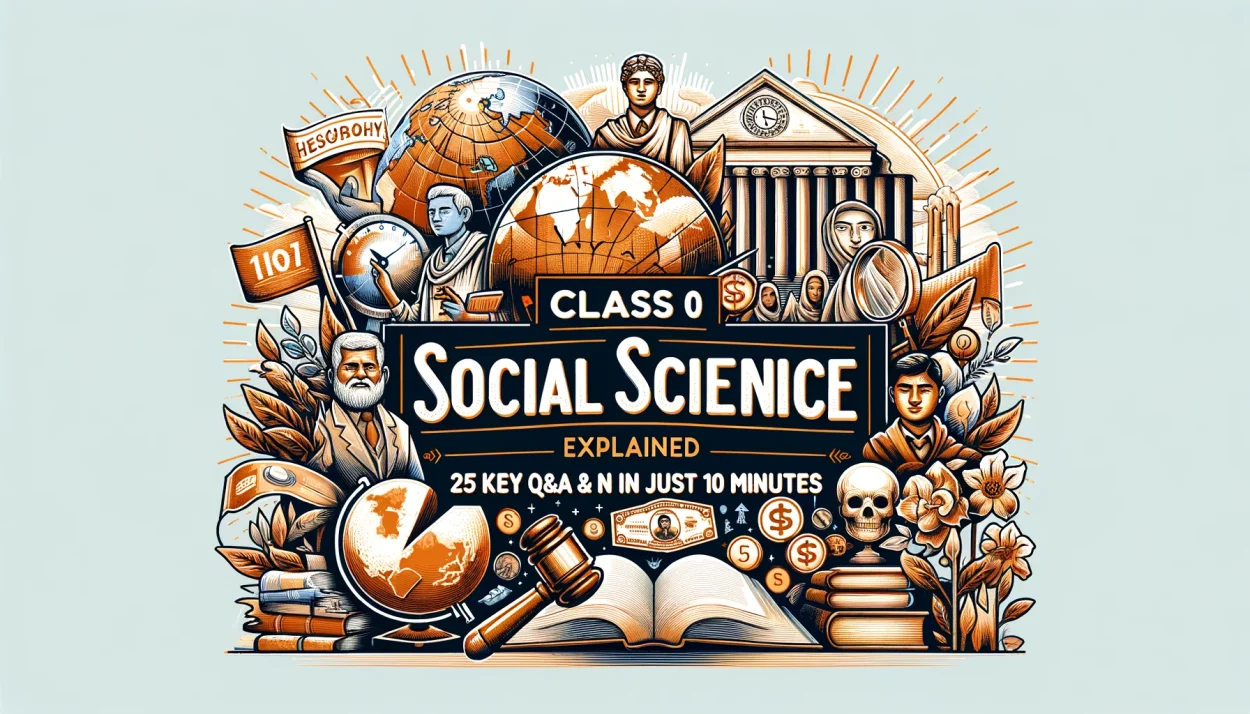
“Class 10 Social Science Syllabus Explained: 25 Key Q&A in Just 10 Minutes”

Below are 25 short questions and answers from the Class 10 Social Science History syllabus, as per NCERT. These cover a range of topics to provide a broad overview of the syllabus.
The Rise of Nationalism in Europe
- What is nationalism?
Nationalism is a belief system that promotes the interests of a particular nation (as in a group of people), especially with the aim of gaining and maintaining the nation’s sovereignty over its homeland. - Who was the architect of the German unification?
Otto von Bismarck. - What was the Zollverein?
The Zollverein was a customs union among German states during the 19th century to manage tariffs and economic policies within their territories. - Define ‘Plebiscite’.
A plebiscite is a direct vote by eligible voters to decide an important public question, such as a change to the constitution or national independence.
Nationalism in India
- What event in 1919 became a turning point in the history of the nationalist movement in India?
The Jallianwala Bagh Massacre. - Who led the Salt March, and in what year?
Mahatma Gandhi, in 1930. - What was the main demand of the Poona Pact of 1932?
It demanded reserved seats for the depressed classes (later known as Scheduled Castes) in the Provincial Legislatures, within the general electorate. - Who founded the Indian National Congress and in which year?
A.O. Hume, in 1885.
The Making of a Global World
- What was the Great Depression, and when did it occur?
The Great Depression was a severe worldwide economic depression that took place mostly during the 1930s, beginning in the United States. - Define ‘Colonization’.
Colonization is the act of setting up a colony away from one’s place of origin. - What role did technology play in making the world a global community?
Technology, especially advancements in transportation and communication, played a crucial role in integrating economies and people across the globe. - What was the Silk Route?
The Silk Route was an ancient network of trade paths that connected the East and West, significant for the trade of goods like silk, spices, and other commodities.
The Age of Industrialization
- What is industrialization?
Industrialization is the process by which an economy is transformed from primarily agricultural to one based on the manufacturing of goods. - What was the impact of the coming of the railways in India?
Railways impacted India by enhancing transportation, promoting trade, leading to urbanization, and integrating markets. - Who were the Luddites?
The Luddites were a group of English workers in the 19th century who destroyed machinery, especially in cotton and woolen mills, that they believed was threatening their jobs. - What is meant by the term ‘Proto-industrialization’?
Proto-industrialization refers to a phase of industrial development preceding and preparing for full industrialization, characterized by the widespread existence of part-time, home-based industrial production.
Print Culture and the Modern World
- How did print culture contribute to the French Revolution?
Print culture spread awareness, ideas of rights and democracy, and criticism of authority, fueling public opinion and participation in the Revolution. - Who invented the first printing press, and in which year?
Johannes Gutenberg, in the 15th century (around 1440). - Define ‘Censorship’.
Censorship is the suppression or prohibition of any parts of books, films, news, etc., that are considered obscene, politically unacceptable, or a threat to security. - How did print culture affect women in the 19th century?
Print culture provided women access to new ideas and knowledge, fostering literacy and promoting individualism and feminist ideas.
Miscellaneous
- What impact did World War I have on European colonies?
European colonies were drawn into the conflict, contributing manpower and resources. The war also accelerated constitutional reforms and the push for independence. - What was the significance of the Treaty of Versailles?
The Treaty of Versailles, signed in 1919, ended World War I. It imposed heavy reparations and territorial losses on Germany, contributing to economic hardship and political instability. - Who was Simon Bolivar?
Simon Bolivar was a Venezuelan military and political leader who played a key role in Latin America’s successful struggle for independence from the Spanish Empire. - What was the impact of the Russian Revolution on the world?
The Russian Revolution inspired a wave of socialist and communist movements around the globe and led to the establishment of communist regimes in various countries. It also resulted in the creation of the Soviet Union, a major world power that played a significant role in global affairs throughout the 20th century.
- Explain the role of women in the nationalist movement in India.
Women played a crucial role in India’s nationalist movement, participating in protests, boycotts, and marches. Figures like Sarojini Naidu, Kasturba Gandhi, and Kamala Nehru became prominent leaders, advocating for both independence and women’s rights. Their involvement not only advanced the struggle for freedom but also marked a significant step towards gender equality in India.